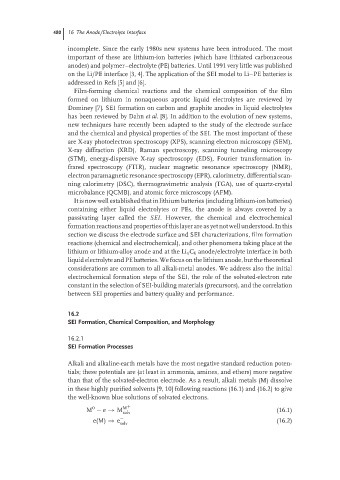Page 507 - Handbook of Battery Materials
P. 507
480 16 The Anode/Electrolyte Interface
incomplete. Since the early 1980s new systems have been introduced. The most
important of these are lithium-ion batteries (which have lithiated carbonaceous
anodes) and polymer–electrolyte (PE) batteries. Until 1991 very little was published
on the Li/PE interface [3, 4]. The application of the SEI model to Li–PE batteries is
addressed in Refs [5] and [6].
Film-forming chemical reactions and the chemical composition of the film
formed on lithium in nonaqueous aprotic liquid electrolytes are reviewed by
Dominey [7]. SEI formation on carbon and graphite anodes in liquid electrolytes
has been reviewed by Dahn et al. [8]. In addition to the evolution of new systems,
new techniques have recently been adapted to the study of the electrode surface
and the chemical and physical properties of the SEI. The most important of these
are X-ray photoelectron spectroscopy (XPS), scanning electron microscopy (SEM),
X-ray diffraction (XRD), Raman spectroscopy, scanning tunneling microscopy
(STM), energy-dispersive X-ray spectroscopy (EDS), Fourier transformation in-
frared spectroscopy (FTIR), nuclear magnetic resonance spectroscopy (NMR),
electron paramagnetic resonance spectroscopy(EPR), calorimetry, differential scan-
ning calorimetry (DSC), thermogravimetric analysis (TGA), use of quartz-crystal
microbalance (QCMB), and atomic force microscopy (AFM).
It is now well established that in lithium batteries (including lithium-ion batteries)
containing either liquid electrolytes or PEs, the anode is always covered by a
passivating layer called the SEI. However, the chemical and electrochemical
formation reactions and properties of this layer are as yet not well understood. In this
section we discuss the electrode surface and SEI characterizations, film formation
reactions (chemical and electrochemical), and other phenomena taking place at the
lithium or lithium-alloy anode and at the Li x C 6 anode/electrolyte interface in both
liquid electrolyte and PE batteries. We focus on the lithium anode, but the theoretical
considerations are common to all alkali-metal anodes. We address also the initial
electrochemical formation steps of the SEI, the role of the solvated-electron rate
constant in the selection of SEI-building materials (precursors), and the correlation
between SEI properties and battery quality and performance.
16.2
SEI Formation, Chemical Composition, and Morphology
16.2.1
SEI Formation Processes
Alkali and alkaline-earth metals have the most negative standard reduction poten-
tials; these potentials are (at least in ammonia, amines, and ethers) more negative
than that of the solvated-electron electrode. As a result, alkali metals (M) dissolve
in these highly purified solvents [9, 10] following reactions (16.1) and (16.2) to give
the well-known blue solutions of solvated electrons.
0
M − e → M M + (16.1)
solv
e(M) → e − (16.2)
solv

